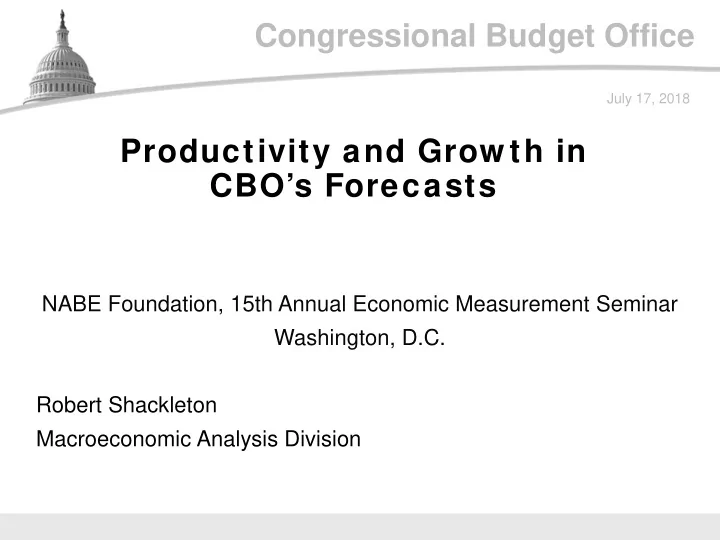

Congressional Budget Office July 17, 2018 Productivity and Grow th in CBO’s Forecasts NABE Foundation, 15th Annual Economic Measurement Seminar Washington, D.C. Robert Shackleton Macroeconomic Analysis Division
CBO What is CBO, and why does it produce an economic forecast? How does CBO prepare its economic forecast? And how does CBO project growth in productivity? 1
CBO The Purpose of CBO’s Economic Forecast The forecast is used primarily as an input to CBO’s 10-year federal budget projections and analyses of legislative proposals. It is a current-law forecast: It assumes that legislation will not change, but changes in policy built into current legislation will occur. For example, recent tax legislation calls for the expiration of certain provisions within the next 10 years. CBO’s current forecast projects economic responses to the expiration of those provisions. 2
CBO CBO’s Approach to Forecasting CBO’s approach involves projections of: Potential (maximum sustainable) output in a neoclassical growth framework, and Actual output in a standard macroeconometric model. The estimate of potential output is mainly based on estimates of: The potential labor force, The flow of services from the capital stock, and Potential total factor productivity in the nonfarm business sector. 3
CBO Average Grow th in Real Potential GDP GDP = gross domestic product. Real potential GDP is adjusted for inflation. 4
CBO Key Estimates in CBO’s Projection of Potential GDP, April 2018 Percent, by Calendar Year Historical Periods Projection 1950– 1950– 1974– 1982– 1991– 2002– 2018– 2017 1973 1981 2000 2001 2017 2028 Overall Economy Potential Output 3.2 4.0 3.2 3.4 3.3 1.8 1.9 Potential Labor Force 1.4 1.6 2.5 1.7 1.2 0.7 0.5 Potential Labor Productivity 1.7 2.4 0.7 1.7 2.0 1.1 1.4 Nonfarm Business Sector Potential Output 3.4 4.1 3.5 3.6 3.7 2.0 2.2 Potential hours 1.3 1.4 2.3 1.8 1.3 0.4 0.4 Capital services 3.4 3.7 3.8 3.6 3.8 2.2 2.3 Potential total factor productivity 1.4 1.9 0.9 1.2 1.5 1.0 1.1 Potential Labor Productivity 2.1 2.7 1.2 1.8 2.3 1.6 1.8 Capital-Labor Ratio 2.0 2.3 1.5 1.8 2.5 1.8 1.8 Memorandum : Potential Output of Other Sectors 2.5 3.7 2.2 2.7 2.0 1.2 1.0 GDP = gross domestic product. 5
CBO Total Factor Productivity in Nonfarm Business Since 2000 Vertical bars indicate the duration of recessions. 6
CBO Why Has Grow th in Total Factor Productivity Slow ed? The slowdown began around 2005, before the recession and financial crisis. It is widespread among industries and international in scope. Five areas of inquiry might shed light on the slowdown: Measurement issues Growth feedbacks Demographic effects Structural issues Long-term innovation 7
CBO The Slow dow n of Grow th in Total Factor Productivity: Measurement Issues Mismeasurement of real (inflation-adjusted) inputs and outputs is persistent. However, measurement issues can account for only a small portion of the slowdown in total factor productivity growth: Mismeasurement does not appear to be worse than it was in the past. Free products no longer measured in output have little value compared with “missing” growth in total factor productivity (for example, photography). Measurement errors related to international supply chains are thought to explain less than 0.1 percentage point of the growth in total factor productivity per year. 8
CBO The Slow dow n of Grow th in Total Factor Productivity: Grow th Feedbacks Growth in the labor supply has slowed dramatically. Aggregate demand recovered slowly in the aftermath of the recession. Both developments lead to relatively modest demand for capital investment. The net result is slower turnover of the capital stock and slower introduction of new technologies. However, there is little evidence of a backlog of technology. 9
CBO The Slow dow n of Grow th in Total Factor Productivity: Demographic Effects Highly skilled and well-educated baby boomers are retiring, lowering the aggregate level of human capital. However, skilled and experienced workers tend to stay in the labor force longer, pushing up the average skill level. Educational attainment has grown more slowly than in previous generations because it is already at a high level. However, educational attainment among younger cohorts has continued to improve, especially during the recession and its slow recovery. 10
CBO The Slow dow n of Grow th in Total Factor Productivity: Structural Issues Declining dynamism: Top firms in many industries continue to have strong productivity growth, but other firms increasingly lag behind. Rates of firm entry and exit have decreased. The share of employment and output accounted for by young firms (historically a source of productivity growth) has fallen. No consensus on causes: Increased barriers to entry? Less contestable product markets? Restrictive land-use regulations increasingly raise housing costs and discourage workers from migrating to denser urban areas, where most growth in productivity occurs. 11
CBO The Slow dow n of Grow th in Total Factor Productivity: A Slow dow n in Basic Innovation Pessimistic view: Innovation from the late 19th century through the early 1970s was unique and unsustainable. Acceleration in total factor productivity during the 1990s and 2000s was a temporary deviation related to information technology. We are “running out of ideas”: Returns to research are declining, and new ideas are not as economically significant. Optimistic view: The pool of potential innovators and the potential market for products are now global. Research tools are greatly improved. Communication of innovations is much more rapid. Major advances in technology can be expected—but because they diffuse slowly, their economic impact will take time. 12
CBO Additional Information Congressional Budget Office, The Budget and Economic Outlook: 2018 to 2028 (April 2018), www.cbo.gov/publication/53651. Robert Shackleton, “Estimating and Projecting Potential Output Using CBO’s Forecasting Growth Model, Working Paper 2018-03 (Congressional Budget Office, February 2018), www.cbo.gov/publication/53558. 13
Recommend
More recommend